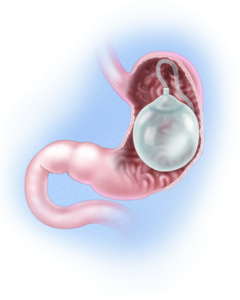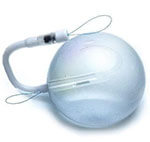Spatz3® Adjustable Intra-Gastric Balloon
What is the Spatz3® Managed Weight Loss Program?
 The Spatz3® Managed Weight Loss Programme is a non-surgical procedure for weight loss that focuses on developing long-term, sustainable, healthy eating habits. The comprehensive, two-part program starts with a soft, intra-gastric balloon placed in your stomach for 12 months to encourage portion control. The Spatz3® balloon has a unique inflation port which allows the balloon volume to be increased or decreased after implantation. Balloon adjustments can be done as often as needed.
The Spatz3® Managed Weight Loss Programme is a non-surgical procedure for weight loss that focuses on developing long-term, sustainable, healthy eating habits. The comprehensive, two-part program starts with a soft, intra-gastric balloon placed in your stomach for 12 months to encourage portion control. The Spatz3® balloon has a unique inflation port which allows the balloon volume to be increased or decreased after implantation. Balloon adjustments can be done as often as needed.
The second part of the program is important because it helps you maintain your weight loss. We guide you through the process of developing a healthy, balanced diet and support you in making healthy lifestyle choices.
Spatz3® is indicated for people who have approximately 10 or more kilograms to lose, or a BMI of 27kg/m2 and above.
What makes the Spatz3® Adjustable Balloon System (ABS) different to other balloons?
The Spatz3® is an adjustable balloon system approved for a one year implantation period. It has a unique inflation port which allows balloon volume additions or subtractions after insertion. This gives your gastroenterologist flexibility to alter the balloon volume as weight loss plateaus. Patients who experience difficulties tolerating the balloon can have their balloon volumes reduced resulting in improved tolerance.
How do I lose weight with the Spatz3® Balloon?
 The Spatz3® balloon works by occupying about one third of the stomach cavity, decreasing the amount of food the stomach can hold. When combined with a healthy diet and exercise the balloon helps control portion sizes and facilitates weight loss. The balloon assists with weight loss via three potential mechanisms; delaying gastric emptying, reducing gastric volume and stimulating ‘stretch’ receptors in the stomach which signals the brain to initiate a feeling of fullness.
The Spatz3® balloon works by occupying about one third of the stomach cavity, decreasing the amount of food the stomach can hold. When combined with a healthy diet and exercise the balloon helps control portion sizes and facilitates weight loss. The balloon assists with weight loss via three potential mechanisms; delaying gastric emptying, reducing gastric volume and stimulating ‘stretch’ receptors in the stomach which signals the brain to initiate a feeling of fullness.
Your dietitian will meet with you throughout the program to help you implement positive dietary and lifestyle modifications. Healthy food choices and lifestyle changes will be easier to maintain with the Spatz3® balloon in place.
How much weight will I lose with a Gastric Balloon?
The average weight loss is 17-25kg over 12 months, however this is dependent on your starting weight and how well you adapt to the lifestyle changes. Your success depends on whether you make the necessary dietary and lifestyle adjustments and how well you apply them. A gastric balloon is a tool to aid weight loss and must be used in conjunction with diet, exercise and a behaviour modification program.
Clinical studies show that 76% of patients still retain significant weight loss two years after Spatz3® balloon removal. Patients who follow the prescribed program, engage in exercise and attend dietetic consultations regularly during the implantation period have a better chance of weight loss maintenance after the balloon is removed.
How is the procedure performed?
The procedure is performed via gastroscopy under deep sedation, in which the balloon is inserted into your stomach via your mouth. Once inside the stomach, the balloon is filled with sterile saline through a small tube attached to the balloon. The balloon insertion takes around 15-20 minutes and you will remain in the recovery room for an hour post insertion for observation.
Balloon adjustments are performed via gastroscopy under sedation, where saline is added or subtracted through the filling tube attached to the balloon. After 12 months, the intra-gastric balloon is removed through the mouth in a similar manner, under the same supervised conditions. Post removal, your support team will continue to guide you toward making healthy lifestyle choices.
How long does it take to recover after the Balloon insertion?
You should plan at least three days of inactivity to recover from the procedure. You will be able to resume normal activity sooner or later depending on how quickly your body adjusts to the balloon. The first few days following insertion of the balloon can be challenging. As the stomach adjusts to the balloon you may feel discomfort and experience nausea, reflux, vomiting, cramping or heartburn. These side effects are temporary and you will be prescribed medication to help manage them.
Are there side effects or complications associated with the intra-gastric balloon?
Cramping, nausea, reflux and vomiting are common symptoms in the first week though generally not harmful. For most these are mild to moderate in severity. Please use recommended medications and the initial liquid diet to alleviate side effects until they subside, typically within three days to a week. If you experience persistent problems follow the guidance of the medical team and drink plenty of fluids.
Will I be able to feel the intra-gastric balloon in my stomach?
There is often some discomfort during the first few days. After that, the primary sensation is feeling satisfied or full after eating or drinking.
Do I need to avoid any medications?
All of the medications that you are taking should be discussed with the gastroenterologist at the initial review. Some medications will require dose adjustment and some medications are not permitted.
Anti-inflammatory medications (non-steroidal anti-inflammatories, NSAIDs) are not permitted. Blood thinners and anti-platelet agents are not permitted (low dose aspirin 75-100 mg is permitted).
How often will my balloon volume be adjusted?
When weight loss plateaus your balloon volume can be increased. The effect of the gastric balloon may diminish after 3-4 months, at which time you can have a balloon adjustment. This can be done as often as required via an endoscopy procedure.
The balloon volume can also be decreased in cases of balloon intolerance. Balloon adjustments will be added into your timeline as required.
Are there any foods I should avoid with a Gastric Balloon?
You may find it difficult to tolerate some foods and this varies from person to person. Common foods known to cause problems may be dry meat, soft white bread, stringy or very fibrous vegetables, sweet corn, peas, nuts, dried fruit, pips and seeds. Avoid these until you have established yourself on your solid diet and always try foods cautiously. If you don’t tolerate a food, try it again in a few weeks’ time. There is a lot of adaptation in the first few months. It is highly likely you will manage most foods with time.
Can I drink alcohol with a Gastric Balloon?
It is not recommended that you drink alcohol for the first three months after your procedure and you may feel the effects of alcohol more quickly than before. Alcohol is very high in calories and contains no nutrients. It can also stimulate appetite which is another reason not to drink frequently to maximize weight loss during the program.
Can I drink carbonated beverages after the procedure?
We advise against carbonated drinks in the first few weeks after the procedure.. Many patients experience discomfort from the gas. It is recommended that you avoid fizzy drinks, beer, champagne, or sparkling water. An exception to this having a sip of sparkling water to combat the effects of bad breath as a result of food getting ‘stuck’ on the balloon.
Will I need to take vitamins after my procedure?
Whilst it is not essential, you may wish to take a multi vitamin and mineral supplement in the initial period after your procedure. The reason for this is that during this time you may only manage very small portions and your diet may not be able to provide all the nutrients that you require. As you progress through the stages and start to get into a routine with your meals you should no longer need this supplementation. See section on Vitamin and Mineral supplements.
How do Gastric Balloons compare to diet and exercise or other weight loss programs?
You can expect to lose three times the weight with a gastric balloon than you would with diet and exercise alone. Many diet programs are difficult to maintain and you can struggle with feeling hungry. With a gastric balloon you eat smaller meals as balloon takes up space in your stomach. You are more in control of your appetite, learn portion control and make healthy changes in your eating habits.
Are there any risks associated with using the Spatz ABS System?
As with other gastric procedures there is the risk of injury to the lining of the digestive tract with the endoscope or the balloon which can result in mucosal damage ulceration, and bleeding. If significant gastric ulceration occurs this can require early balloon removal. Perforation is a very rare complication which requires operative intervention. Spontaneous deflation of the balloon releases a blue color into the stomach which turns your urine green. If this happens, the balloon should be removed immediately. Migration of the gastric balloon causing bowel obstruction requiring surgical removal is rare.
